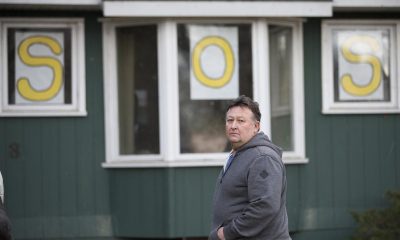Anglais
Secret 1988 Olympic report goes behind the scenes of Ben Johnson’s drug-test hearing
Published
5 années agoon
By
admin
[ad_1]
An Olympic anti-doping report kept secret for 30 years has revealed that some athletes at the Seoul Summer Games, including two medallists, escaped punishment for potential drug infractions while others — including world champion Canadian sprinter Ben Johnson — were summarily disqualified.
Details contained in the 1988 Olympic Medical Commission documents obtained by the Star provide the first official accounting of how top anti-doping scientists responded to the Games’ cheating athletes and in particular, how they handled the Olympics’ most explosive and enduring drug scandal: Johnson’s positive test for an anabolic steroid.
/https://www.thestar.com/content/dam/thestar/news/canada/2019/01/13/secret-1988-olympic-report-goes-behind-the-scenes-of-ben-johnsons-drug-test-hearing/_1ben_john_medium_wide.jpg)
/https://www.thestar.com/content/dam/thestar/news/canada/2019/01/13/secret-1988-olympic-report-goes-behind-the-scenes-of-ben-johnsons-drug-test-hearing/_3ben_race_start.jpg)
Quick background: On Sept. 24, 1988, Johnson, then 26, won the Olympic 100 metres in world record time, beating American archrival Carl Lewis in the Games’ most hyped showdown. Three days later, the Toronto runner was stripped of his medal and his record, and was flying home from Seoul in disgrace. Lewis was awarded the gold.
Though Johnson would later admit that he, in fact, had used banned anabolic steroids during training, his story remains compelling as more details about his treatment in Seoul — including his withheld lab report and alterations made to parts of it, a Star investigation found — continue to emerge three decades later.
When asked about the new revelations, Johnson, who regularly deals with the public during his travels for speaking engagements, said his story strikes them the same way he sees it.
“People think ‘Who in their right mind would take something (banned) leading up to Games, knowing they’re going to win at the Games and that they will be tested?’ ” said Johnson, a 57-year-old grandfather of three.
The IOC did not return a request for comment on the report’s release.
Read more:
Is it time to see Ben Johnson in a new light?
The 134-page medical commission document makes it clear there was no benefit of the doubt for Johnson. He was the lone track-and-field athlete disqualified from Seoul for doping.
Information in the report suggests the IOC’s anti-doping police doubled down on quashing the Canadian’s theory that sabotage could explain the presence in his urine of the metabolites of stanozolol, a muscle-building steroid commonly used in training periods prior to competitions. Johnson had claimed a stranger in the doping control room after the race sat close to him and could have spiked his beer.
In a departure from its routine, the commission presented an unofficial testing method to detect long-term steroid use as additional damning evidence against Johnson — a method not applied to other athletes discussed in the archived document as proof of cheating. In addition, one commission member proposed to block attempts by Johnson to challenge his doping infraction by not permitting future tests on the runner’s race-day water bottle and his other medications to undermine the Seoul findings. (Later testing would show that the water bottle was free of steroid traces.)
Meanwhile, others received leniency. That included a group of track-and-field athletes from the U.S. and Britain, according to the IOC document.
Eight unnamed Americans, tested during competition shortly before the Games, were not sanctioned after their cases were discussed in Seoul. Star British sprinter Linford Christie barely avoided Olympic disqualification, despite one commission member declaring Christie’s test result after the 200 metres “a clear case of doping.”
In the 100-metre race, Christie was awarded the silver medal after Johnson was sent home. The British runner passed his drug test in that sprint, held a few days before the 200 metres, without incident.
Johnson maintains he was “targeted” at the Games for disqualification.
“I came in clean and came out dirty,” he said in an interview.
/https://www.thestar.com/content/dam/thestar/uploads/2019/01/13/ben1-0.jpg)
In most Olympics during the early days of competition, challenges with venues and logistics arise. Seoul was no different. The medical commission report noted there were security problems at doping control rooms and lab issues, including:
New “wide-necked bottles” for athletes’ urine samples sometimes leaked, causing potential problems with labelling numbers “as some bottles had been replaced”; people without special identification passes were entering secure doping control room areas (where athletes provided samples) — in one case, an overly curious Turkish team doctor was forcibly removed from volleyball’s control room; four “instruments” in the main IOC anti-doping lab broke during the Games, pushing lab testing to capacity midway through the Olympics.
One thing that pleased the commission was the skill of the main lab where urine samples, collected at various sports venues around Seoul, would be analyzed for a long list of prohibited substances. It reported to its members that a pair of planted samples by system testers had been correctly identified.
“Two test positive samples had been placed among the boxing controls and had been successfully detected by the laboratory for (the anabolic steroid) oxandrolone and caffeine,” it was noted in a meeting on Sept. 19, 1988.
Oxandrolone was printed on Johnson’s 1988 lab report paperwork, then scratched out. Stanozolol was the final finding.
In Seoul, medical commission members didn’t always agree among themselves when considering athletes’ explanations for doping infractions.
In Linford Christie’s case, for instance, there was a “lengthy discussion” among members after which “it was decided that that athlete should be given the benefit of the doubt” that the levels of pseudo-ephedrine in his system were linked to ginseng consumption. The vote was not unanimous. Christie’s case was publicly discussed during the Seoul Games by British Olympic team officials.
As for the two Olympic medallists who avoided sanctions, the Star is not identifying them other than to say they were not track-and-field athletes.
The eight American athletes had their identities protected in the medical commission report while almost every other athlete with potential doping infractions was identified — including one athlete who had also tested positive for a banned substance prior to the Seoul Games.
(One unnamed cyclist is mentioned in medical commission notes, referencing his “low concentration of an anabolic steroid because of cream applied in his trousers.” It’s unclear if the cyclist was in Seoul; there were no more details about him.)
The American cases went before International Amateur Athletics Federation officials, who listened to a presentation from the United States Olympic Committee on Sept. 19, according to medical commission notes. The notes go on to state that “the cases had concerned over-the-counter herbal preparations containing ephedrine” and that the IAAF “was satisfied with the report submitted and ruled that no sanctions would be taken and the case was now closed.”
/https://www.thestar.com/content/dam/thestar/uploads/2019/01/13/carl-lewis-0.jpg)
In 2003, Sports Illustrated reported that at the 1988 U.S. Olympic trials, Carl Lewis tested positive three times for “small amounts” of banned stimulants found in cold medications. Lewis was initially disqualified from the Seoul Games but the USOC overturned the decision on his appeal, agreeing that it was inadvertent doping, the sports magazine reported.
Lewis is not named in the 1988 IOC Medical Commission report.
When Ben Johnson’s case came before the commission, it was all over in about three hours.
In Seoul in 1988, Montreal lawyer Richard Pound — who was a well-regarded IOC vice-president — defended Johnson.
Neither Johnson nor his coach, the late Charlie Francis, attended the hearing; others, including Roger Jackson, then the president of the Canadian Olympic Association, and Canadian chief medical officer William Stanish, an orthopedic surgeon, were at the session that began at 10 p.m. on Sept. 26.
The 1988 report stated that early in the meeting, it was noted that commission member Prof. Manfred Donike had been “responsible for the analysis of the B sample” and he explained the findings to the group. The B-sample testing confirmed the steroid findings in Johnson’s A sample.
According to the report, Pound told the commission the Canadian delegation didn’t want to challenge the scientific results but broached a “certain lack of security” between the end of the 100-metre final and the time Johnson provided his urine sample, at the doping control station at the track-and-field stadium.
The report goes on to say Pound “stressed the build-up which had surrounded the 100m race and the two principle athletes (Johnson and Lewis) involved” and that Pound “felt there had been a general breakdown in procedures following the race, rendering the result of the doping tests questionable.”
Pound stated that people who accompanied Johnson to doping control, including an RCMP officer assigned to the athlete, claimed there were “many other people in the dope control station other than those whose presence was required for the test.”
The lawyer also raised the possibility that Johnson’s water bottle had been tampered with when he put it in a basket with his warm-up clothes to race. Pound told commission members a stranger was in the doping control room, offering to get the sprinter beer (Johnson got his own) but who sat “very close to the athlete.” According to meeting notes, it was later alleged — though it’s unclear by whom — that the unknown person had been seen with Lewis, which commission chairman Alexandre de Merode “pointed out as possibly quite harmless.”
(The Star tracked down the stranger, a friend of Carl Lewis’ named Andre Jackson, in a 2016 investigation.)
/https://www.thestar.com/content/dam/thestar/uploads/2019/01/13/ben4-0.jpg)
Before the commission, Pound described Johnson as “a slow learner” but an athlete who “retained the importance of collecting his own beer.”
Pound further expanded the sabotage theory — a theory that would be debunked later at a royal commission.
He said stanozolol was a drug that metabolized quickly, “thus favoring its use should anyone wish to ‘frame’ someone else,” and that it tightened muscles, something not “sought for by a sprinter,” according to report notes. Pound added Johnson was an experienced athlete who knew he’d be tested after an Olympic race; had been tested several times in 1988 with all results negative; and “that considering the reasonable doubt which surrounded the test, an athlete of such calibre was entitled to the benefit of the doubt.”
The anti-doping experts pushed back.
Dr. Arne Ljungqvist, a Swedish commission member who was also chairman of the International Amateur Athletics Federation Medical Commission, was in the doping control room when Johnson arrived after his race. Ljungqvist said he questioned staff there, but “staff were convinced that no unauthorized persons had been present,” according to the meeting notes.
Even so, the archived document states that “regarding entry of the unauthorized persons to the dope control station,” Ljungqvist reported that a large sign had been placed after the concern was raised at the entrance to the track-and-field doping control room.
Prof. Donike told the Canadian delegation that sabotage was not consistent with the steroid profile interpreted from the failed test — meaning long-term use was detected by the endocrine profiling method Donike had pioneered.
He also acknowledged the magnitude of Johnson’s predicament. Donike, who is now deceased, said “the entire commission was perfectly aware of the implications of a positive case for such an athlete and for sport in general.”
Pound “clarified” that Johnson had a negative test just weeks earlier at a Zurich race. After that, the Canadians, including Pound, left the meeting room, and de Merode opened the floor for discussion.
Behind closed doors, Donike said a negative test before the Games “was of no consequence” and concluded “a single dose application just prior to testing could be excluded.” Donike was the commission member who didn’t want Johnson’s test challenged by analyses of his water bottle or medications, according to the archived document.
/https://www.thestar.com/content/dam/thestar/uploads/2019/01/13/001021-dick-pound-0.jpg)
Chairman de Merode asked for opinions in the room, including that of an IAAF representative. After that, “the Commission voted unanimously for the exclusion of Ben Johnson from the Games of the XXIVth Olympiad in Seoul.”
The commission’s recommendation, which came at about 12:45 a.m. Sept. 27, 1988, was forwarded to the IOC’s executive board later that morning. The board accepted it and Johnson was disqualified. He lost his medal and his world record of 9.79 seconds.
Thirty years later, Johnson said Pound didn’t aggressively defend him before the IOC Medical Commission.
“I believe he didn’t reach out far enough or strong enough to protect me,” Johnson said, after learning more about the report.
In fact, the report refers to the ethics of whether Pound was in a conflict. One member, Dr. Kenneth Fitch of Australia, didn’t feel it was “correct for an IOC vice-president to appear before the IOC Medical Commission in order to protect an athlete from his country.” The commission unanimously requested that de Merode speak to the IOC president, Juan Antonio Samaranch, “to ensure that such a situation did not occur in the future.”
Pound says he had previously cleared the matter with Samaranch.
In a recent phone interview, Pound said he’s never seen the Olympic Medical Commission document from 1988. He also said science made it clear that preparing any defence of Johnson in Seoul would be difficult.
“If you’re caught with the sample being analyzed containing the stanozolol metabolites, you’re dead,” Pound said.
Research by Patrick Oberli, a Swiss-based sports journalist at Le Matin Dimanche
Mary Ormsby is a reporter and feature writer based in Toronto. Reach her via email: mormsby@thestar.ca
TOP STORIES, DELIVERED TO YOUR INBOX.
[ad_2]
Source link
You may like
-


Five outside-the-box housing ideas that Toronto should try, according to report
-


Edmonton’s funicular was a popular river valley ride in its first year: report – Edmonton
-


Young families scrimp to own homes in Canada’s big cities, report finds
-


SNC-Lavalin: Scheer demande à Trudeau de lever le secret professionnel
-


‘A major challenge:’ Report by railway in fatal B.C. derailment studied impacts of winter weather
-


Calgary joins list of cities grappling with costs of crumbling Olympic venues
Anglais
Nostalgia and much more with Starburst XXXtreme
Published
3 années agoon
août 10, 2021By
admin
Get a taste of adventure with Starburst XXXtreme based on the legendary NetEnt Game. The nostalgic themes are sure to capture fans of the classic version as they get treated to higher intensity, better visuals, and features. The most significant element of the game is its volatility. Patience will not be an essential virtue considering the insane gameplay, and there is a lot of win potential involved. It retains the original makeup of the previous game while adding a healthy dose of adrenaline.
Starburst Visuals and Symbols
The game is definitely more conspicuous than before. The setting happens over a 5-reel, 3-row game grid with nine fixed win lines, which function if a succession from the left to the right reel is present. Only those players that that attain the highest win per bet line are paid. From a visual standpoint, the Starburst XXXtreme slots illustrates lightning effects behind the reels, which is not surprising as it is inherited from the original version. Available themes include Classic, Jewels, and Space. The game is also available in both desktop and mobile versions, which is advantageous for players considering the global pandemic. According to Techguide, American gamers are increasingly having more engaging gaming experiences to socialize to fill the gap of in-person interaction. Starburst XXXtreme allows them to fill the social void at a time when there is so much time to be had indoors.
Starburst XXXTreme Features
Players get to alternate on three features which are Starburst Wilds, XXXtreme Spins, and Random Wilds. The first appears on reels 2,3, or 4. When these land, they expand to cover all positions while also calculating the wins. They are also locked for a respin. If a new one hits, it also becomes locked while awarding another respin. Starburst XXXtreme offers a choice between two scenarios for a higher stake. In one scenario with a ten times stake, the Starburst Wild is set on random on reels 2,3, or 4, and a multiplier starts the respin. The second scenario, which has a 95 times stake, starts with two guaranteed starburst wilds on reels 2,3, or 4. it also plays out using respin game sequence and features. The game also increases the potential with the Random Wilds feature to add Starburst Wilds to a vacant reel at the end of a spin. Every Starburst Wild gives a random multiplier with potential wins of x2, x3, x5, x10, x25, x50, x100, or even x150.
The new feature is sure to be a big hit with the gaming market as online gambling has shown significant growth during the lockdown. AdAge indicates the current casino customer base is an estimated one in five Americans, so Starburst XXXtreme’s additional features will achieve considerable popularity.
What We Think About The Game
The gambling market has continued to diversify post-pandemic, so it is one of the most opportune times to release an online casino-based game. Thankfully Starburst XXXtreme features eye-catching visuals, including the jewels and space themes. These attract audience participation and make the gameplay inviting. The game also has a nostalgic edge. The previous NetEnt iteration featured similar visuals and gameplay, so the audience has some familiarity with it. The producers have revamped this version by tweaking the features to improve the volatility and engagement.
That is characterized by the potential win cap of 200,000 times the bet. Starburst XXXtreme does not just give betting alternatives for players that want to go big. The increase of multipliers also provides a great experience. If the respins in the previous version were great, knowing that multipliers can go hundreds of times overtakes the game to a new level.
Players should get excited about this offering. All of the features can be triggered within a single spin. Whether one plays the standard game or takes the XXXtreme spin route, it is possible to activate all of the features. Of course, the potential 200,000 times potential is a huge carrot. However, the bet size is probably going to be restricted and vary depending on the casino. It is also worth pointing out that a malfunction during the gameplay will void all of the payouts and progress. Overall, the game itself has been designed to provide a capped win of 200,000 times the original bet.
Anglais
‘We’re back’: Montreal festival promoters happy to return but looking to next year
Published
3 années agoon
juillet 23, 2021By
admin
In downtown Montreal, it’s festival season.

In the city’s entertainment district, a musical act was conducting a sound check on stage Friday evening — the second day of the French-language version of the renowned Just For Laughs comedy festival. Tickets for many of the festival’s free outdoor shows — limited by COVID-19 regulations — were sold out.
Two blocks away, more than 100 people were watching an acoustic performance by the Isaac Neto Trio — part of the last weekend of the Festival International Nuits d’Afrique, a celebration of music from the African continent and the African diaspora.
With COVID-19 restrictions continuing to limit capacity, festival organizers say they’re glad to be back but looking forward to next year when they hope border restrictions and capacity limits won’t affect their plans.
Charles Décarie, Just For Laughs’ CEO and president, said this is a “transition year.”
“Even though we have major constraints from the public health group in Montreal, we’ve managed to design a festival that can navigate through those constraints,” Décarie said.
The French-language Juste pour rire festival began on July 15 and is followed by the English-language festival until July 31.
When planning began in February and March, Décarie said, organizers came up with a variety of scenarios for different crowd sizes, ranging from no spectators to 50 per cent of usual capacity.
“You’ve got to build scenarios,” he said. “You do have to plan a little bit more than usual because you have to have alternatives.”

Anglais
MELS new major movie studio to be built in Montreal
Published
3 années agoon
juillet 23, 2021By
admin
MONTREAL — MELS Studios will build a new film studio in Montreal, filling some of the gap in supply to meet the demand of Hollywood productions.
MELS president Martin Carrier said on Friday that MELS 4 studio construction will begin « as soon as possible », either in the fall or winter of next year. The studio could host productions as early as spring 2023.
The total investment for the project is $76 million, with the Quebec government contributing a $25 million loan. The project will create 110 jobs, according to the company.
The TVA Group subsidiary’s project will enable it to stand out « even more » internationally, according to Quebecor president and CEO Pierre Karl Péladeau. In the past, MELS Studios has hosted several major productions, including chapters of the X-Men franchise. The next Transformers movie is shooting this summer in Montreal.
Péladeau insisted that local cultural productions would also benefit from the new facility, adding that the studio ensures foreign revenues and to showcase talent and maintain an industry of Quebec producers.
STUDIO SHORTAGE
The film industry is cramped in Montreal.
According to a report published last May by the Bureau du cinéma et de la télévision du Québec (BCTQ), there is a shortage of nearly 400,000 square feet of studio space.
With the addition of MELS 4, which will be 160,000 square feet, the company is filling part of the gap.
Carrier admitted that he has had to turn down contracts because of the lack of space, representing missed opportunities of « tens of millions of dollars, not only for MELS, but also for the Quebec economy. »
« Montreal’s expertise is in high demand, » said Montreal Mayor Valérie Plante, who was present at the announcement.
She said she received great testimonials from « Netflix, Disney, HBO and company » during an economic mission to Los Angeles in 2019.
« What stands out is that they love Montreal because of its expertise, knowledge and beauty. We need more space, like MELS 4, » she said.
There is still not enough capacity in Quebec, acknowledged Minister of Finance, the Economy and Innovation Eric Girard.
« It is certain that the government is concerned about fairness and balance, so if other requests come in, we will study them with the same seriousness as we have studied this one, » he said.
Grandé Studios is the second-largest player in the industry. Last May, the company said it had expansion plans that should begin in 2022. Investissement Québec and Bell are minority shareholders in the company.
For its part, MELS will have 400,000 square feet of production space once MELS 4 is completed. The company employs 450 people in Quebec and offers a range of services including studio and equipment rentals, image and sound postproduction, visual effects and a virtual production platform.


MAPEI Canada inaugure l’agrandissement de son usine à Laval, au Québec

Le Gala Elles reconnaissent célèbre les femmes remarquables de l’industrie de la construction

Préparez votre maison pour l’hiver afin d’éviter les réclamations d’assurance

Quatre façons de commencer à travailler dans le domaine des ventes

La Commission indépendante soutient le recours de la Cour suprême contre le déni des droits des non-francophones par le Québec

Justin Trudeau est un raciste contre les Noirs et les Premières Nations – 14 signes

Enfants aux études loin de la maison : Trois conseils pour veiller à la santé de leurs finances

Règles et règlements que toutes les entreprises canadiennes doivent connaître

Épargnez pour l’avenir grâce à nos trucs financiers pour la rentrée

Efficacité énergétique: 10 façons économiques de l’améliorer

Ces légendes du baccara vous dévoilent leurs secrets

Retard de vol : le devoir de la compagnie envers ses passagers

Nostalgia and much more with Starburst XXXtreme

Même les jeunes RÉPUBLIQUES se lassent du capitalisme, selon les sondeurs américains — RT USA News

« Aucune crise climatique ne causera la fin du capitalisme ! »

Innovation : le capitalisme « responsable », faux problème et vraie diversion

Vers la fin du Capitalocène ?

Le “capitalisme viral” peut-il sauver la planète ?

Livre : comment le capitalisme a colonisé les esprits

Patrick Artus : « Le capitalisme d’aujourd’hui est économiquement inefficace »

Body found after downtown Lethbridge apartment building fire, police investigating – Lethbridge

Comment aider un bébé à développer son goût

Head of Toronto Community Housing placed on paid leave

Salon du chocolat 2018: les 5 temps forts

This B.C. woman’s recipe is one of the most popular of all time — and the story behind it is bananas

Gluten-Free Muffins

We Try Kin Euphorics and How to REALLY Get the Glow | Healthyish

Man facing eviction from family home on Toronto Islands gets reprieve — for now

Condo developer Thomas Liu — who collected millions but hasn’t built anything — loses court fight with Town of Ajax

27 CP Rail cars derail near Lake Louise, Alta.

Ontario’s Tories hope Ryan Gosling video will keep supporters from breaking up with the party

Renaud Capuçon, rédacteur en chef du Figaroscope

Paris : chez Cécile Roederer co-fondatrice de Smallable

Ontario Tories argue Trudeau’s carbon plan is ‘unconstitutional’

100 years later, Montreal’s Black Watch regiment returns to Wallers, France

Trudeau government would reject Jason Kenney, taxpayers group in carbon tax court fight

Ford Ranger Raptor, le pick-up roule des mécaniques

Los Angeles poursuit The Weather Channel pour atteinte à la vie privée

Le Forex devient de plus en plus accessible aux débutants

The Bill Gates globalist vaccine depopulation agenda… as revealed by Robert F. Kennedy, Jr.
Trending
-

 Anglais5 années ago
Anglais5 années agoBody found after downtown Lethbridge apartment building fire, police investigating – Lethbridge
-

 Santé Et Nutrition4 années ago
Santé Et Nutrition4 années agoComment aider un bébé à développer son goût
-

 Anglais5 années ago
Anglais5 années agoHead of Toronto Community Housing placed on paid leave
-

 Styles De Vie5 années ago
Styles De Vie5 années agoSalon du chocolat 2018: les 5 temps forts
-

 Anglais5 années ago
Anglais5 années agoThis B.C. woman’s recipe is one of the most popular of all time — and the story behind it is bananas
-

 Santé Et Nutrition6 années ago
Santé Et Nutrition6 années agoGluten-Free Muffins
-

 Santé Et Nutrition5 années ago
Santé Et Nutrition5 années agoWe Try Kin Euphorics and How to REALLY Get the Glow | Healthyish
-

 Anglais5 années ago
Anglais5 années agoMan facing eviction from family home on Toronto Islands gets reprieve — for now


